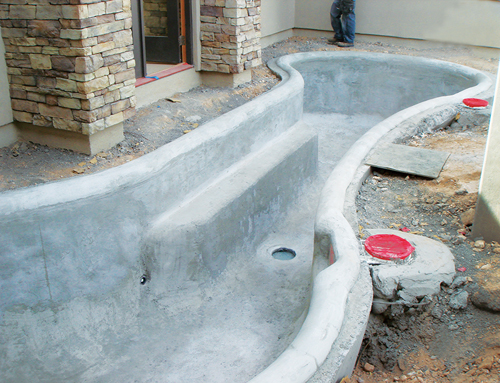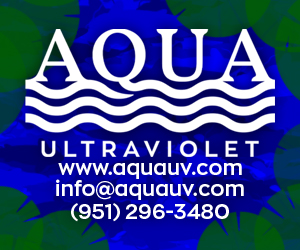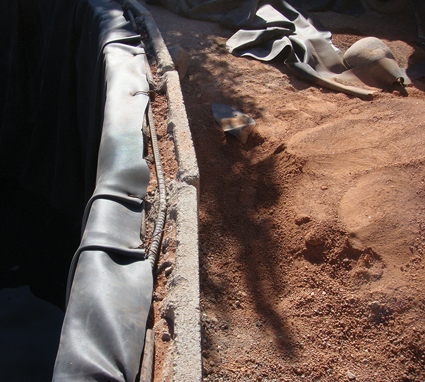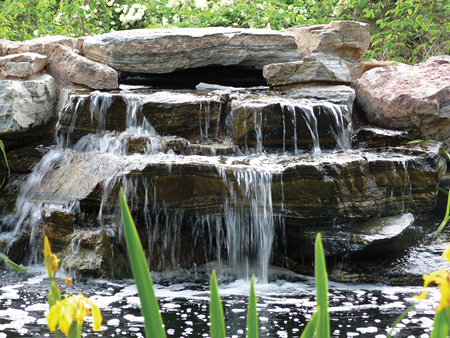
There is a battle brewing between some of the builders who construct ponds with concrete and those builders who use pond liner. This is not a battle that needs to be fought. Concrete is a structural component and liner is a sealing component. Each has its place and its purpose. The purpose of one shouldn’t be confused with the purpose of the other.
Liner has been around the pond industry since its inception and has a very important role to play as a waterproofing membrane. It has no structural capacity and, for the most part, conforms to whatever surface it’s covering. When installed correctly, liner can last for a decade or more.
Vinyl, polyethylene and PVC liners are available, but EPDM rubber liner is the most common and seems to work the best for ponds. Each has its drawbacks, but EPDM rubber liner is the easiest to work with, seam and repair when it gets punctured. Liner must be supported by a structure, which is usually the soil it is laying on, with the edge finished above waterline
Many ponds are created as “loose edge” ponds, and many are built with a method that captures the upper edge in concrete or has the upper edge supported on a concrete shelf with a short wall up above the waterline to protect and secure the liner’s edge. This prevents the edge from sliding below the waterline, creating a leak over the top of the liner. Loose liner hidden below edge rock is one of the most prevalent sources of leaks. The edge gets pushed below the waterline by human and animal traffic, or it erodes with runoff, creating an area of the edge that water can escape over.These types of leaks are easy to find and repair just by pulling the liner up and supporting it again with soil, rocks or boulders. One way of dealing with the liner edge is to bring the liner straight up and fold it straight back down, forming a rolled upper edge that gets secured with the edge treatment rocks. This seems to be a superior way of accomplishing the “loose edge” method because the liner edge isn’t spread out under a section of loose rocks or dirt, and if there is an issue you readily have a folded piece of liner to work with.
Concrete — Structure without Seal
Concrete is used with liner to form a structural support for the sealing surface but not as a sealing element. Concrete by itself will crack over time so it must be sealed with something after installation. The pool industry uses a plaster coat or a coat of Hydro Ban or other sealing agent when tiling over it. The plaster coat is the sealing coat, but when the concrete cracks, so does the plaster. Algae and the layers of biofilm that naturally grow on the surface of all live water features have an effect on the plaster coat. This living surface etches into the plaster coat and destroys it over time.
A “pebble tech” surface (plaster with small stones in it) is a better option simply because much of the surface is small stone, with the exposed plaster as a much smaller percentage of the surface. When a swimming pool cracks and leaks, you drain it, remove the plaster coat with a small jack-hammer and replaster it. This is not an option for a pond full of fish.
It is commonly stated that “There are two types of concrete: concrete that’s cracked and concrete that’s going to crack.” Many installers use crystalline additives like Xypex, which are great. These compounds form crystalline structures that can fill small cracks and voids and “self-seal” as the concrete separates. This works well to a certain extent, but if the soil isn’t solid enough; has a lot of clay in it, causing it to expand and contract; or is extremely sandy and moves a bit; the cracks become unmanageable. In colder climates the freeze/thaw cycle will break concrete up over time, and in areas with a high water table, concrete can be broken up as the ground moves. In these areas pool contractors build with vinyl liners to seal the surface as the concrete cracks.
>> Best Pond Practices Series | An ongoing, multi-part series on best practices in Pond Construction
There are many products that are used to seal concrete. Epoxy coatings can be used, but because epoxy coating systems harden and aren’t flexible, they crack through along with the cracks in the concrete. There are rubberized coatings that stay flexible when cured and these are generally agreed upon to be superior. My personal favorite is polyurea.
Polyurea
Polyurea is not a “do it yourself” coating. It’s a spray-applied coating that is applied with special equipment by a trained technician. Polyurea has a part A and Part B, similar to epoxy. The two components are mixed as they exit the applicator gun at high pressure and high temperature. They combine and transform into plastic as they exit their nozzles, creating a flexible and extremely tough coating with an elasticity of approximately 400 percent as it forms on the surface.
Polyurea can be sprayed onto a geotextile fabric over the ground or sprayed over a variety of structural forms to create a waterproof liner on virtually any shape without folds or seams. Concrete, cement block, wood, plastic, several types of foam and steel can all be used as structural support systems for polyurea. Unlike rubber liner, roots can never grow through it and it’s not going to tear or puncture over time under heavy boulders as liner can. Polyurea has been speed tested to over 75 years and has a variety of applications in the waterproofing industry.
When using polyurea, the structure can be a complete concrete shell, or it can be constructed as a collar with an open center of dirt, or even as a loose-edge pond with no collar … although some edge is preferable. All penetrations must be mechanically clamped just as you would with rubber liner. Flanged bottom drains, skimmers and return fittings are all available and are the same products you would use for a rubber liner pond.In a pond with a concrete collar and a dirt floor, a geotextile fabric is laid down over the dirt portions and attached to the collar and components with polyurea. This fabric is similar to the underlayment used with liner, but much smoother and stronger. Waterfalls can be built successfully with both polyurea and liner, but my experience has been that liner is easier to work with in a small waterfall situation with small boulders because it’s more flexible. Small waterfalls can be built with liner overlapped and secured onto the polyurea pond edge easily, but large waterfalls with tons of boulders should be constructed over polyurea to prevent future ruptures and leakage.
I believe all commercial ponds for businesses, hotels and resorts should be built with polyurea. Step up your game! Build it once and forget it without worry!
The battle isn’t concrete versus liner. It should be about structural integrity that will vary depending on the geography and location you are building in and the proper sealing method for the situation.






Pingback: Let Bacteria Do the Work! - POND Trade Magazine
Detailed drawings showing information on specific areas, connections and
construction techniques may be required. How it was created affects how fast or how high it moves or
flies when it is kicked. Sometimes the contractor says they can give you something better for a lower price,
and it’s tempting to say yes.
Nice and a very informative article. I would like to say a big thanks to you for sharing this great article with us. Keep share more.